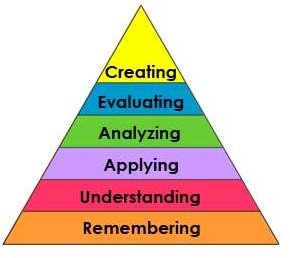Using Bloom's Taxonomy for Teachers, With a Kindergarten Classroom as an Example
Hierarchal Progression
There are new domains to Bloom’s Taxonomy. They are Remembering, Understanding, Applying, Analyzing, Evaluating, and Creating. The levels are meant to be hierarchal, that is you must start at the Remembering level before progressing to the Understanding level and so on. See the photo of the Bloom’s Pyramid to the right.
The levels at the bottom are considered to be the easiest levels. Some may even argue that most teachers teach to the bottom levels, that is recall of information, comprehending information and applying information.
In the school where I taught, we were presented with a challenge to review the levels, choose a topic, and plan lessons to teach Bloom’s Taxonomy across all of its levels.
It took several weeks to complete and admittedly, putting Bloom’s Taxonomy into practice is rewarding and enlightening.
Describing the (New) Levels
The new levels seem to be very similar to the old, with new verbs to describe each level. You can find a full definition of each level and the verbs to describe the student’s learning in the reference section below.
Remembering: can the student recall or remember the information?
Understanding: can the student explain ideas or concepts?
Applying: can the student use the information in a new way?
Analyzing: can the student distinguish between the different parts?
Evaluating: can the student justify a stand or decision?
Creating: can the student create new product or point of view?
*These levels and verbs are referenced below.
Bloom’s Taxonomy in the Classroom
Honestly, when presented with this challenge I did not think it feasible to put Bloom’s Taxonomy into practice for a Kindergarten class in late October, but soon realized that it was not such an insurmountable task as I had imagined. The topic that we chose to incorporate Bloom’s Taxonomy into was a recent field trip taken to the pumpkin patch.
Starting at the Remembering level we asked the students to recall or identify what they saw at the pumpkin patch. Students dictated their sentences on a predictable chart, I saw a __________. We followed the predictable chart format and at the end of the week cut up the sentences. The students reformed them, glued them to their paper and illustrated the picture. Patricia Cunningham is known for her writing about predictable charts. This task showed that they remembered what they experienced.
Next we went to the Understanding level. At this level we compared and contrasted a book we had read, “Apples and Pumpkins”, by Anne Rockwell, to the actual trip on a Venn Diagram. So, could they compare the difference in a non-fiction book to the actual trip?
Next we went to the Applying level. Here students learned to illustrate and label the beginning, middle and end of a completely unrelated book (“Mrs. Wishy Washy”) and given the same paper, had to illustrate and label the beginning, middle and end of the field trip.
Analyzing was next. The students chose one part of their beginning, middle and end to write more about. They had to “zoom in” on a small moment that happened and elaborate more about it. They analyzed one part of the trip in more detail.
Evaluating was where the students developed a list of their own rules or standards to follow at the pumpkin patch. Now that they had an experience, could they evaluate what they learned? Could they make a list of the rules they learned? This task was not to remember the rules we gave them, but to evaluate certain rules that made the trip successful for everyone.
Last, at the Creating level, the students made their own pumpkin patch pamphlets to recommend this field trip to someone else. I found this level to be the most challenging and enlightening. To begin, they had to answer the question, “What made this a great trip?” If they were able to evaluate the trip, they would say, it was great because of something that they could do or saw. Most students at this age wanted to say that the trip was fun and struggled to give examples of why.
In the next section, we’ll explore some of the challenges and rewards in using Bloom’s Taxonomy.
The Challenges
The biggest challenges to using Bloom’s Taxonomy in the Kindergarten classroom were the developmental age and the academic

inexperience of the students. I did notice that as the level went higher, so did the degree of difficulty for them.
At the Remembering level, all students were able to recall what they saw, but the challenge for some of the students came when restructuring the sentences, For others, it was having the fine motor skills to cut with scissors. As this was the beginning of the school year this was to be expected.
At the Understanding level, all students were able to contribute to the Venn Diagram as a whole group activity, but some struggled with the task independently. The struggle was not in using the Venn Diagram, but in labeling their pictures as they had not yet had enough writing experience yet, but again as it was the beginning of the school year, this was to be expected.
For beginning Kindergarteners, Applying became a bit more challenging. Discerning the beginning, middle and end of the trip was difficult to some, if not most students. At this time of the year most of them said, “and then we went home” for the end of the trip. Again, I think it was related to their limited experience with the writing process and expected. The other challenge at this stage was to assist new writers in labeling their pictures and dictating sentences for the whole class for each story part.
At the Analyzing level, students were able to pick one part of their story to tell more about (“zoom in”) easily, but again had to be coached into providing specific details (for example, “tell me more about that”). They still wrote vague generalizations about the trip.
Evaluating was somewhat challenging for them as well. The students wanted to give bus rules or general field trip rules. Eventually, again with coaching, they created rules like, do not take your friend’s pumpkin; pick one pumpkin; do not pick a rotten pumpkin; sit down on the hay ride; and do not frighten the horses or they stop.
Creating was the most difficult level for the students. It took much questioning from the teacher aide and I for them to realize that “we had fun” was not the only reason to enjoy the trip and that they needed to describe the trip and elaborate about the fun that they had.
The Rewards
Putting Bloom’s Taxonomy into practice in the classroom was a rewarding experience because it challenged me to make sure that my

lesson plans included Analyzing and higher. I learned much about student’s developmental ability at the beginning of Kindergarten and how important labeling pictures with them is. I think that repeating the process with a different field trip toward the end of the year would have shown their academic and developmental progress.
I found myself using Bloom’s Taxonomy in my thinking process throughout the rest of the school year and the years beyond. For example, after this year, I started an annual, fun, end-of-the-year activity that included making a pamphlet for incoming Kindergarteners from the graduating class.
They independently chose and wrote about many topics, all they had learned that year, what they did, where they went, their special moments, the friends they made and so forth. When the new Kindergarteners came in for orientation they were presented with the pamphlets. The new parents were astounded that their child could be writing like that by the end of the school year and it was exciting for the graduating Kindergarteners to see and share all that they had learned.
References
- This article was written from Laurie Patsalides’ classroom experience. Note- the article was originally written before the new Taxonomy; however, the new Taxonomy information was added and the experiences here still fit the new levels. Thanks to one of my readers!
- Overbaugh, R. & Schultz, L., Old Dominion University, Bloom’s Taxonomy
